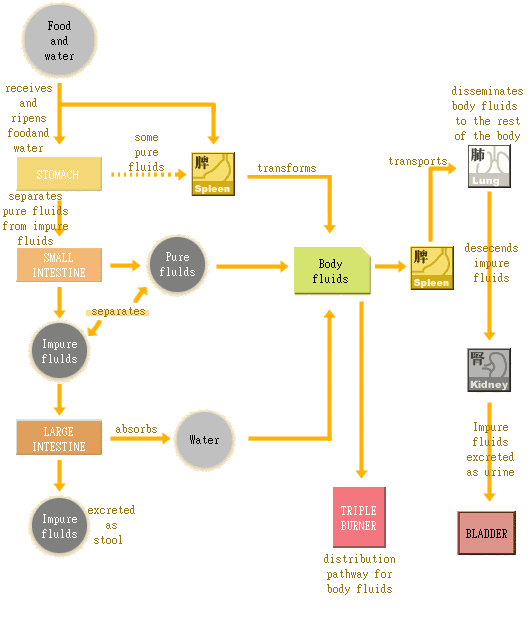Special Pathological Conditions
During the development course of illness, pathological products will be formed. They can in turn act directly or indirectly on tissues or organs, and cause new pathological conditions. As mentioned in previous chapter, endogenous evils such as wind, cold, dampness, dryness and heat (or fire) are the kind of changes. In addition, retained fluid, phlegm and blood stasis are special pathological products, when they formed and reached to certain amount, some new health problems can be resulted.
Phlegm and Retained Fluid
The body's fluid metabolism is managed and monitored by the lungs, spleen, kidneys, and triple burner mutually. When these organs are affected by the six evils, improper diet or seven emotions, the organs functioning and the fluid metabolism will be disturbed, which in turn causes the detention of water or body fluids, resulting in the dampness, phlegm or retained fluid formed and accumulated inside the body.

Features of dampness, phlegm and retained fluid
- Disturbing qi and blood activities: dampness, phlegm and retained fluid tend to stay in organs and meridians, and affect their qi (vital energy) and blood activities. When phlegm or retained fluid accumulated in the lungs, there will be chest stuffiness, coughing and breath shortness; dampness accumulated in the middle burner, there will be distention in gastric and abdominal regions, nausea, vomiting, loose bowels or diarrhea; phlegm or retained fluid filled up the meridians and collaterals, there will be limb numbness, joint stiffness, and even paralysis; phlegm can also invade locally to develop sores or abscesses.
- Causing various changes: accumulation of dampness, phlegm or retained fluid can result in a wide range of pathogenic conditions. For example, retained fluid upflowing to the head will lead to serious dizziness; excess fluid flowing to the lower limbs will lead to swelling; dampness accumulated in exterior body will lead to general heaviness; dampness stopped in the middle burner will affect the spleen and stomach functioning; vomiting and nausea can be due to phlegm stayed in the stomach.
- A lingering course: health problems caused by dampness, phlegm and retained fluid tend to come and go, and will progress slowly. Commonly associated conditions like asthma, dizziness, chest pain, stroke, thyroid disease or deep muscular abscess are often lingering in nature, and regarded as clinical difficulties.
- Disturbing shen easily: the heart rules shen, accumulation of phlegm or retained fluid can affect heart functioning, leading to mental disturbances. For example, dampness and phlegm up stirring the orifices will lead to dizziness, heavy headedness and spiritual fatigue; phlegm congested in the heart and orifices will lead to chest stuffiness, palpitations, mental dullness or even mental disorder; phlegm and fire stirring the heart will lead to insomnia, bad temper, uncontrollable laughing and even madness.
- Glossy and greasy tongue coating is an important clinical indication for the occurrence of dampness, phlegm or retained fluid pathogens.
Blood Stasis
Blood stasis refers a non-smooth blood circulation, or localized stagnated blood flow, or blood escapes from the vessels that fail to dissipate. Blood stasis is usually associated with qi deficiency, qi stagnation, excess cold evil or heat evil in the blood, and also traumatic injuries. When blood stasis formed, body tissues will lose their proper blood-nutrient supplies, leading to a range of complicated manifestations. Features of blood stasis include stabbing pain, dark bluish or purplish discoloration of the skin or mucous membranes, tumors, bleeding (dark purplish and clotty blood), dark complexion, dry and coarse skin, purplish dark tongue with tiny bleeding spot, and a thready and uneven pulse.
- Pain: pain due to blood stasis is often stabbing and fixed in nature, which is worse at night. Some may even experienced a colicky pain, such as angina, gallbladder stone pain, or kidney stone pain. When blood stasis and qi stagnation are concurrence, the pain will be distending or dull in nature.
- Tumors: tumors due to blood stasis are fixed in place; the body surface can be found bruise, swelling, or redness. They may palpable when developed inside the abdomen.
- Bleeding: blood stasis formed inside the body can result in bleeding, the blood tends to be darkish purplish and clotty.
- Fever: fever caused by blood stasis tends to be worse at night, individuals may feel thirsty but don’t like to drink for relief. When blood stasis blocks the striae, there will be both chills and feverish sensations.
- Blood stasis looks: purplish lips, nails, and tongue, ecchymosis (bleeding patches under the skin or mucous membrane), petechial (bleeding spots under the skin or mucous membrane), and varicose veins under the tongue. For long term blood stasis, individuals can have a darkish complexion, the skin and nails are coarse and dry, or spider angioma (swollen blood vessels) found slightly beneath the skin surface, in serious cases the abdominal wall may appear varicose veins too.
- Blood deficiency: blood stasis interrupts the blood production process, and thus long term blood stasis will lead to blood deficiency eventually.


